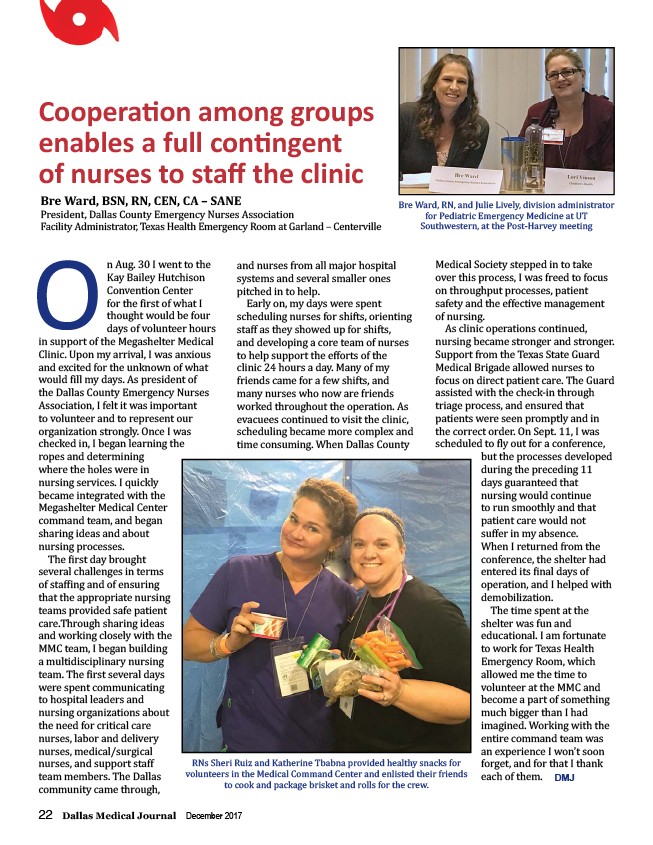
Cooperati on among groups
enables a full conti ngent
of nurses to staff the clinic
n Aug. 30 I went to the
Kay Bailey Hutchison
Convention Center
for the ��irst of what I
thought would be four
days of volunteer hours
in support of the Megashelter Medical
Clinic. Upon my arrival, I was anxious
and excited for the unknown of what
would ��ill my days. As president of
the Dallas County Emergency Nurses
Association, I felt it was important
to volunteer and to represent our
organization strongly. Once I was
checked in, I began learning the
ropes and determining
where the holes were in
nursing services. I quickly
became integrated with the
Megashelter Medical Center
command team, and began
sharing ideas and about
nursing processes.
The ��irst day brought
several challenges in terms
of staf��ing and of ensuring
that the appropriate nursing
teams provided safe patient
care.Through sharing ideas
and working closely with the
MMC team, I began building
a multidisciplinary nursing
team. The ��irst several days
were spent communicating
to hospital leaders and
nursing organizations about
the need for critical care
nurses, labor and delivery
nurses, medical/surgical
nurses, and support staff
team members. The Dallas
community came through,
Bre Ward, RN, and Julie Lively, division administrator
and nurses from all major hospital
systems and several smaller ones
pitched in to help.
Early on, my days were spent
scheduling nurses for shifts, orienting
staff as they showed up for shifts,
and developing a core team of nurses
to help support the efforts of the
clinic 24 hours a day. Many of my
friends came for a few shifts, and
many nurses who now are friends
worked throughout the operation. As
evacuees continued to visit the clinic,
scheduling became more complex and
time consuming. When Dallas County
22 Dallas Medical Journal December 2017
for Pediatric Emergency Medicine at UT
Southwestern, at the Post-Harvey meeting
Medical Society stepped in to take
over this process, I was freed to focus
on throughput processes, patient
safety and the effective management
of nursing.
As clinic operations continued,
nursing became stronger and stronger.
Support from the Texas State Guard
Medical Brigade allowed nurses to
focus on direct patient care. The Guard
assisted with the check-in through
triage process, and ensured that
patients were seen promptly and in
the correct order. On Sept. 11, I was
scheduled to ��ly out for a conference,
but the processes developed
during the preceding 11
days guaranteed that
nursing would continue
to run smoothly and that
patient care would not
suffer in my absence.
When I returned from the
conference, the shelter had
entered its ��inal days of
operation, and I helped with
demobilization.
The time spent at the
shelter was fun and
educational. I am fortunate
to work for Texas Health
Emergency Room, which
allowed me the time to
volunteer at the MMC and
become a part of something
much bigger than I had
imagined. Working with the
entire command team was
an experience I won’t soon
forget, and for that I thank
each of them. DMJ
Bre Ward, BSN, RN, CEN, CA – SANE
President, Dallas County Emergency Nurses Association
Facility Administrator, Texas Health Emergency Room at Garland – Centerville
RNs Sheri Ruiz and Katherine Tbabna provided healthy snacks for
volunteers in the Medical Command Center and enlisted their friends
to cook and package brisket and rolls for the crew.
O